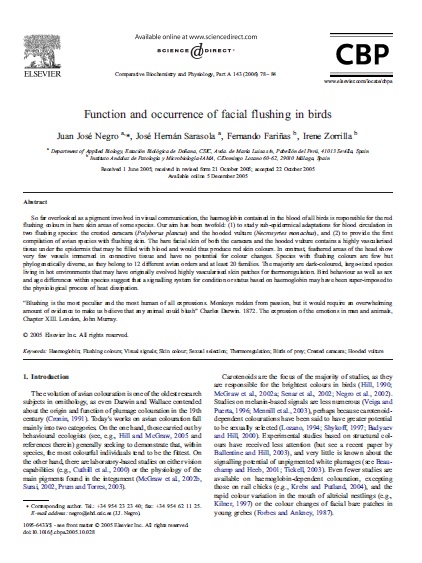چكیده
اطلاعات گذشته پیرامون نقش داشتن رنگدانه هایی در برقراری ارتباط بصری در چهره وجود داشت، هموگلوبین های موجود در خون همه پرندگان، مسئول ایجاد رنگ قرمز و برافروخته در بخش های بدون پوشش پر در برخی از گونه ها می باشد. هدف ما از این بررسی دو موضوع را شامل می شود: (1) مطالعه سازگاری های دستگاه گردش خون در زیر پوست چهره دو گونه که رفتار برافروخته شدن و گلگون شدن چهره در آن ها وجود دارد: Polyborus plancus و گونه ای کرکس با نام Necrosyrtes monachus. و (2) تهیه نخستین لیست از گونه هایی که این رفتار در آن ها وجود دارد. بخش های بدون پوشش پوست صورت در دو گونه یاد شده در لایه زیرپوست دارای سیستم مویرگی فشرده ای هستند که وقتی از خون پر شود، قادر است رنگ پوست را قرمز نماید. در مقابل، در زیر پوست بخش های پوشیده شده از پر مویرگ ها فاقد فشردگی بوده و توانایی تغییر رنگ پوست در مناطق را نخواهند داشت.
کلیدواژهها: هموگلوبین، Polyborus plancus، تغییر رنگ، پرندگان، رنگدانه.
Abstract
So far overlooked as a pigment involved in visual communication, the haemoglobin contained in the blood of all birds is responsible for the red flushing colours in bare skin areas of some species. Our aim has been twofold: (1) to study sub-epidermical adaptations for blood circulation in two flushing species: the crested caracara (Polyborus plancus) and the hooded vulture (Necrosyrtes monachus), and (2) to provide the first compilation of avian species with flushing skin. The bare facial skin of both the caracara and the hooded vulture contains a highly vascularised tissue under the epidermis that may be filled with blood and would thus produce red skin colours. In contrast, feathered areas of the head show very few vessels immersed in connective tissue and have no potential for colour changes. Species with flushing colours are few but phylogenetically diverse, as they belong to 12 different avian orders and at least 20 families. The majority are dark-coloured, large-sized species living in hot environments that may have originally evolved highly vascularised skin patches for thermoregulation. Bird behaviour as well as sex and age differences within species suggest that a signalling system for condition or status based on haemoglobin may have been super-imposed to the physiological process of heat dissipation.
“Blushing is the most peculiar and the most human of all expressions. Monkeys redden from passion, but it would require an overwhelmin amount of evidence to make us believe that any animal could blush” Charles Darwin. 1872. The expression of the emotions in man and animals, Chapter XIII. London, John Murray.
 قالبهای پاورپوینت
قالبهای پاورپوینت



نقد و بررسیها
هنوز بررسیای ثبت نشده است.